3 June Afternoon.
At the end of the tour, the group split up. In what would prove to be a rare occurrence, Groud went off to make travel arrangements leaving all of us on our own. I don’t recall where the Brazilians went (though I believe they wound up in a tea house) but John and Anne walked to Behai Park near the Forbidden City to try to get some close-in panoramic city views. Erin Rosemary and I decided to visit the Summer Palace which we were told was about a 40-minute Metro ride from central Beijing.
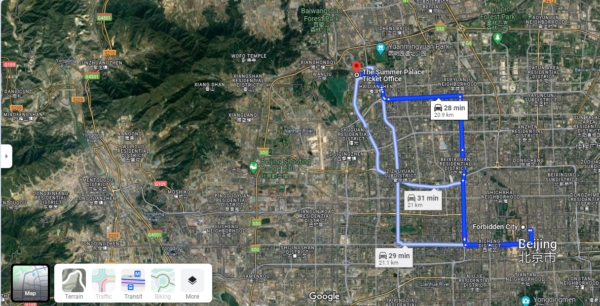
We considered sharing a cab but Kevin (Wong Pying) suggested we ride the bus a few stops to get out of the area of the Forbidden City since the cabbies their tended to overcharge tourists. We rode the bus to the last stop and alit in what appeared to me to be a hutong – one of the old traditional neighborhoods that once comprised most of Beijing. We never got off the main street in our search for a place to eat lunch but the alleyways running off it looked like the descriptions I’d read of hutongs.
Hutong or no, we spotted a moderately busy restaurant and stepped in for lunch. Though there were no English translations (I’m thinking this restaurant doesn’t see many foreigners), the menu was, as many are, pictorial. There was still some guesswork involved and we ended up with breaded fried fish pieces (bone in) in a brown ginger garlic sauce, rice with vegetables, shrimp, and pork that had a soupy consistency, and something green that none of us could identify but that reminded me of a Korean dish I’ve had but don’t clearly remember. I tried to order a Tsing-Tao and the young waitress seemed confused because they served a different brand of beer. (The recommendation for Americans is not to drink tap water in Beijing. In fact, we were urged not to drink tap water anywhere on the route.) I accepted the alternate.
After lunch we took a cab to the Summer Palace. The fare was 44 yuan – about half what Kevin told us to expect. (I’ve updated the Conversions post to include currency.) The Summer Palace is vast beyond words. This picture is but one small area:. 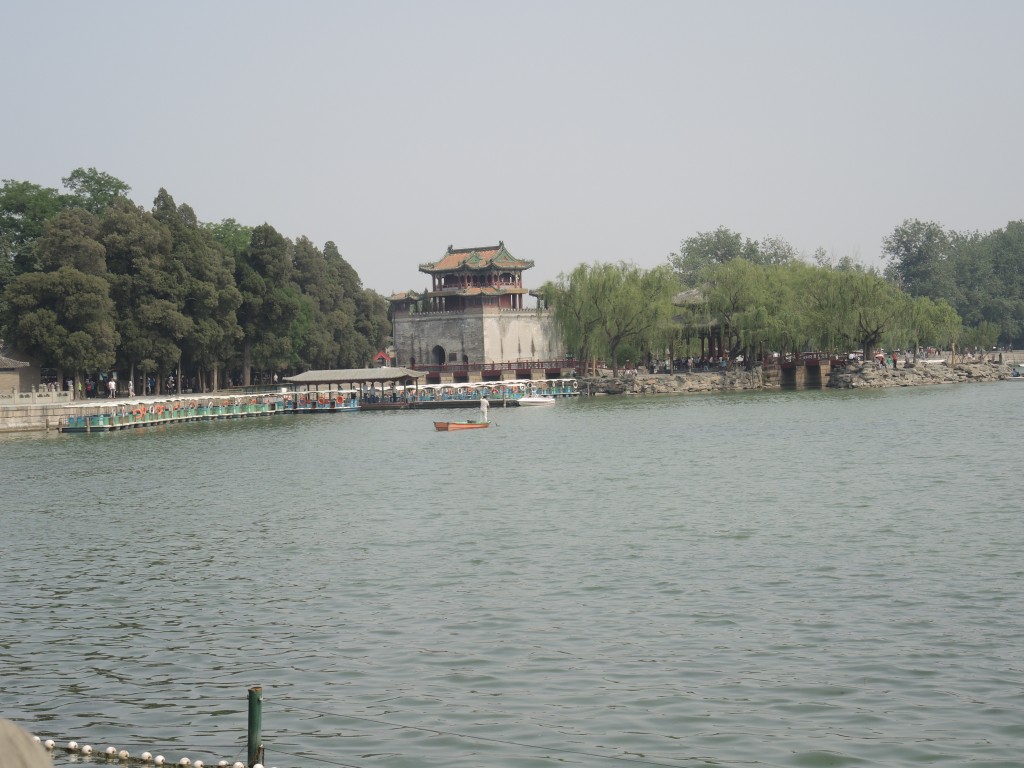
It’s three times the size of the Imperial City – about 290 hectares – and seems to be largely a monument to the ego and excess of the Dowager Empress Cixi. She effectively ruled China for nearly half a century beginning in about 1860. For those interested in reading more about Cixi, you can do so here.
The opulence of this court must have been incomprehensible to the peasants of the time. We spent about four hours in a place one could easily spend days. Our ticket included admission to the grounds plus four additional sites within that have individual admission fees. Our first stop was the Wenchang Gallery. This is among the newer buildings on the grounds and is the largest exhibition hall in the Chinese gardens. It contains an overwhelming number of relics spanning the time from the Shang Dynasty that began about 1000 BCE through the end of the Qing Dynasty in 1912. From there we meandered to the Garden of Virtue and Harmony which proved not to be a garden at all but a theater where Cixi would watch performances of Chinese Opera.
We were fortunate enough when we entered the pavilion to see a live performance.
The day was hot and walking was from time to time mildly strenuous up and down uneven steps and hills so we stopped for an ice cream on the way to the Tower of the Fragrance of the Buddha.
The tower is a three story octagon and is about thirty six and a half meters tall. It’s something of the centerpiece of the Summer Palace landscape. Inside the tower is a bronze cast statue of the thousand-handed Guanshiyin Buddha. Had it not been for the smog, some of the views of Beijing to the east and the mountains to the west as we climbed Longevity Hill to the Tower and then higher would have been spectacular but alas were a bit beshrouded. Honestly, I shudder to think of the particulate matter I’m inhaling. It’s tangible enough to dispel any concerns about second-hand cigarette smoke.
Our final stop was Suzhou Street. Though quaint, it’s really nothing more than a reproduction of a street that would not have been a part of the Palace. Today, it’s mainly a place to induce tourists to spend money. I can’t fault the effort. For more pictures of the Summer Palace including Suzhou Street you can go here.
We rode the metro back to the hotel. Even for foreigners, the Beijing Metro is easy to navigate. The lines are coded both numerically and by color though I think the color is a better reference point for everyone.
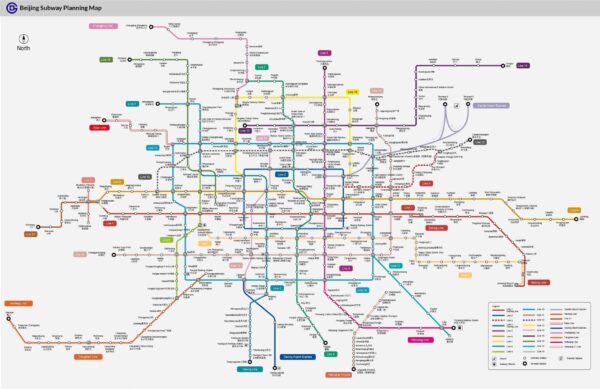
[Metro map from Travel China Guide.]
Each car has an electronic map of the route with transliterated station names and the upcoming station flashes red as you approach it then changes to solid green when you arrive. Announcements are in Chinese and English. Still, it’s a good idea to count stops because the cars can get crowded and if you’re lucky enough to find a seat (vacant seats are occupied within milliseconds) the signs can be blocked by the standees. Also, as in any subway I’ve ridden, the announcements can be muffled by a poor sound system or overrun by chatter.
Before our tour ended, Kevin had offered to get us tickets to see the famous Chinese Acrobats and five of us elected to do that. So, after a brief stop at the hotel for a quick shower and change of shirt for me (I don’t know what the others did), we met Kevin in the lobby and he escorted us to the theater. There was no time for dinner so I grabbed some caramel popcorn and Coke Zero at the theater. Erin also shared with me some Jaffa’s – an Australian candy with an outer shell akin to an M & M but with a soft orange flavored chocolate center.
Though the show was fairly short – about an hour and twenty-five minutes with a ten minute intermission – some of the feats were remarkable and seeing them live certainly trumps seeing the show on video or film. Truth be told, I was glad for the brevity because I was tired from the day and would have had to fight to stay awake much later. Kevin met us after the show and rode the Metro with us back to the hotel. Before I went to bed, I made a quick check of my four email accounts. I note this because although I have a voltage converter and an adapter that is labeled to fit Chinese outlets, the adapter doesn’t fit – at least in this hotel – so I’m doing all I can to conserve power on my phone and hope that I’ll be able to recharge when we get to Mongolia. Tomorrow, it’s on to the Great Wall.
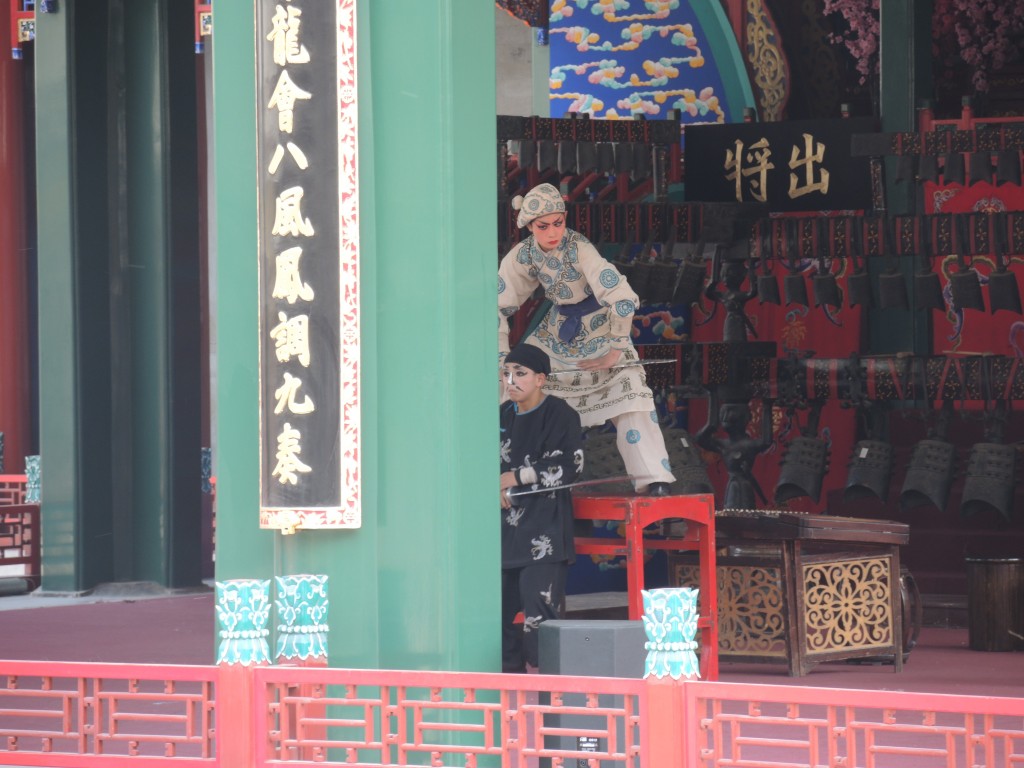
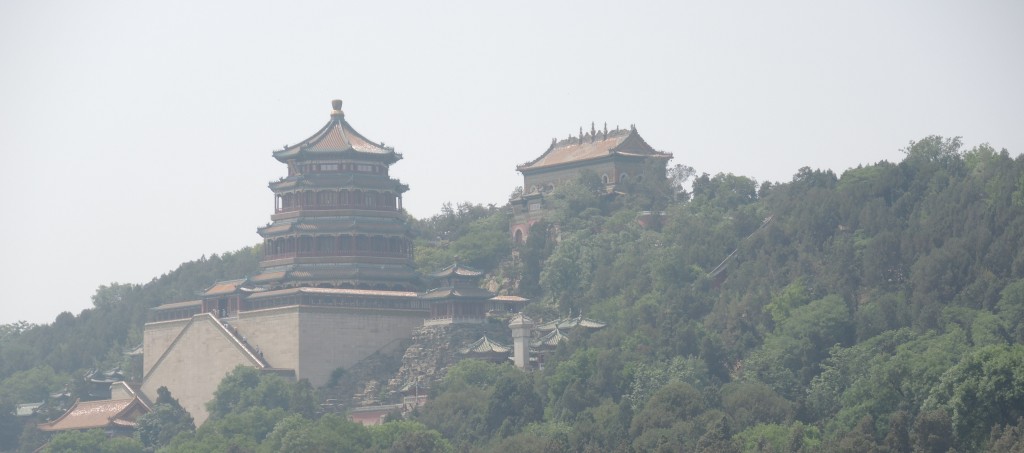
Enjoying your engaging commentary/impressions. I find pictures somewhat sad because I can just imagine how spectacular and beautiful some of those landscapes shots could be with clear, blue skies. What a shame that the water and skies look so gray (US spelling of color) especially since the close up shots of the buildings reveal the myriad of color and detail that the Chinese are so skilled at creating.
Great pictures, my family is visiting for the holiday and we enjoyed the viewing your pictures. I especially enjoyed the picture showing your reflection.
wonderful post, thank you. rbs